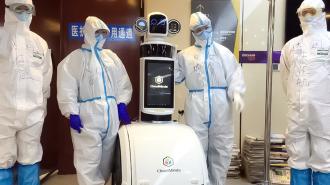On March 10, Wuhan, China, closed the last of the 16 temporary medical facilities it established to address an overwhelming number of COVID-19 cases. But before it did, one coronavirus hospital ward served as the setting for an experimental program in which robots — not human staff — tended to all the patients’ needs.
The project was a collaboration between the Chinese Academy of Sciences research institute and officials from the Hubei province. At the ward, robots took care of 200 people showing early symptoms of COVID-19 — a remarkable example of technology’s role in combating the novel coronavirus.
The Robot-Run Coronavirus Hospital
Traditionally, healthcare workers have had little choice but to put themselves in harm’s way during infectious disease outbreaks — someone needs to tend to patients, and they’re the people trained to do that job.
The surge in patients during an outbreak makes workers more in-demand than ever; and the more they work, the more likely they are to catch the infection. By March 2, more than 3,300 healthcare workers in China had reportedly caught COVID-19. At least 13 have died.
In the experimental program, robots took care of 200 people showing early symptoms of COVID-19.
In order to protect healthcare workers — and help alleviate an already overburdened system — China turned to robots. The idea behind the experimental coronavirus hospital ward in Wuhan was to keep medical staff safe by letting robots take care of patients with mild COVID-19 symptoms.
Artificial intelligence tech company CloudMinds donated 12 sets of robots to the program, according to a report by The Global Times. The robots were divided into six types, each boasting its own abilities, including: food delivery, ward disinfection, and disposal of medical waste.
Some of the robots could check patients’ vital signs, transmitting the information to human doctors for review. Others helped keep morale up in the coronavirus hospital ward by leading patients in dance routines and posing for pictures.
Tech to the Rescue
The robot-run coronavirus hospital ward in Wuhan is just one example of how technology is contributing to the COVID-19 response effort.
We’ve seen robots rolling through residential areas spraying disinfectant, while drones do the same from the sky — when they aren’t scolding people caught outside without protective face masks.
Meanwhile, thermal-imaging tech affixed to drones and police helmets has allowed officials to scan crowds for people with elevated temperatures, a characteristic symptom of COVID-19.
Artificial intelligence has also played a major role in the coronavirus response. Some computer scientists have built algorithms capable of tracking COVID-19 and predicting its future spread. Others have developed AIs to detect coronavirus by analyzing CT scans of lungs.
COVID-19 Vaccine
Some tech-based coronavirus response efforts have yet to pay off — but if they do, they could help bring the outbreak to an end outright.
Machine-learning startup Deepmind used AI software to model the structure of six SARS-CoV-2 proteins. It then released the data in the hopes that scientists might be able to use it to develop a COVID-19 vaccine.
With a vaccine in hand, health officials could dramatically stem the spread of COVID-19 — and that can’t happen soon enough.






